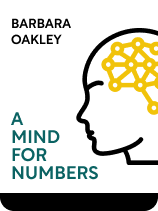

This article is an excerpt from the Shortform book guide to "A Mind for Numbers" by Barbara Oakley. Shortform has the world's best summaries and analyses of books you should be reading.
Like this article? Sign up for a free trial here .
Have you read A Mind for Numbers? What do you know about the book’s author and publication?
Because the world is increasingly dependent on technology, being competent in technical subjects such as math and science is beneficial both for your career and life in general. A Mind for Numbers by Barbara Oakley aims to help you learn math and science well enough that they become intuitive.
Keep reading to learn about the book’s author, publication, context, and more.
Overview of A Mind for Numbers by Barbara Oakley
You may not realize it, but your brain has an extraordinary capacity for complex calculations: Tasks like stepping over a garden hose as you walk across your lawn require tremendously complex computations, and yet they seem easy because your brain does them intuitively. Barbara Oakley wrote A Mind for Numbers to help you learn math and science well enough that they, too, become intuitive. In this book, Oakley presents principles about how your brain works and builds strategies for learning and studying upon these principles.
About the Author
Barbara Oakley is a professor of engineering at Oakland University who also teaches a MOOC (massive open online course) called “Learning How to Learn: Powerful Mental Tools to Help You Master Tough Subjects” through Coursera. To date, this class has reached over two million students.
Oakley grew up thinking she was technically inept. From childhood through her career in the US Army, she struggled with technical subjects. However, recognizing the benefits of technical competence, she determined to overcome her technophobia and eventually earned a doctorate in systems engineering.
Since 2007, Oakley has authored or co-authored numerous books and articles on the relationship between neuroscience, social behavior, and learning, including Learn Like a Pro, Mindshift, and Uncommon Sense Teaching.
Connect With the Author
The Book’s Publication
A Mind for Numbers was Oakley’s seventh book, published in July 2014 under the TarcherPerigee imprint of the Penguin Random House Network. However, it was her first book on the subject of study skills, which would become the subject of her most popular books. Significantly, it was published the month before Oakley’s online class, “Learning How to Learn,” debuted: The content of the course and the book closely parallel one another, and thus reinforce each other if taken together. That said, the book can also stand by itself.
In 2014, A Mind for Numbers ranked 14th on the New York Times’ list of best-selling science books. Based on Amazon’s best-seller rankings, it’s Oakley’s most popular book to date.
The Book’s Intellectual Context
A Mind for Numbers by Barbara Oakley is primarily a synthesis of established neuroscience and study techniques. It brings relevant information together and makes it actionable for students, rather than disclosing original research or new discoveries. Nevertheless, Oakley also provides original insight into the subjects that she synthesizes.
In this guide, we will briefly explore the origins of many of the concepts Oakley presents, and compare the way she develops them to the way others have used them, if applicable. For example, we’ll discuss how Oakley’s “focused-mode” and “diffuse-mode” thinking correlate to the concepts of “vertical” and “lateral” thinking proposed by Edward de Bono half a century earlier.
The Book’s Critical Reception
Most book reviewers praised A Mind for Numbers for its applicability, saying either that it helped them in their studies or that they wished they had read it when they were in school. It holds an average rating of four stars or more on platforms such as Amazon and Goodreads.
However, the book was not without its critics. Both positive and critical reviewers pointed out that A Mind for Numbers is about learning techniques that can be applied to any field of study, rather than just math and science. This led positive reviewers to praise the book for its wide applicability, while critical reviewers expressed disappointment that it did not delve into math and science more deeply.
Commentary on the Book’s Approach
Oakley’s overall approach in the book is as follows:
- First, she presents principles of neuroscience.
- Then, she builds strategies for effective studying based on these principles.
- Next, she illustrates and substantiates these strategies with examples and testimonials.
- Finally, she challenges the reader to apply these strategies with exercise questions.
Within each chapter, the principles and strategies are often interspersed with anecdotes and testimonials. This led some critical reviewers to accuse the book of being sloppy in its organization and full of tangential information that doesn’t contribute significantly to the book’s main principles or purpose.
However, it’s possible that Oakley intentionally buffered the book’s weightier content with lighter anecdotes. One of the book’s main points is the importance of alternating between focused and diffuse thinking when learning new things or solving difficult problems. Focused thinking involves focusing intently on something to understand it in detail, while diffuse thinking corresponds to a more relaxed mental state. The handoff between the two modes plays an important role in the learning process. In this light, Oakley’s organization allows the reader to alternate naturally between focused and diffuse thinking while reading the book, and thereby learn the material better.
Commentary on the Book’s Organization
One theme that Oakley stresses in A Mind for Numbers is the importance of revisiting a concept repeatedly to engrain it in your memory. Consistent with this principle, she repeatedly revisits topics throughout the book. For example, she introduces her discussion of habitual procrastination (and how to avoid it) in Chapter 5, reiterates and expands upon it in Chapter 6, moves on to other topics in Chapters 7 and 8, and then returns to the subject of procrastination again in Chapter 9.
This cyclical approach to the organization of the book has its pros and cons. On the one hand, if you read the book from front to back, the repetition ensures that you will remember the key concepts better than if you were only exposed to them once. On the other hand, the cyclical repetition can make it more difficult to find something again if you wish to refer back to it. The progression of logic might also be easier to follow if the book were more linear, and the repetition makes the book less concise.

———End of Preview———
Like what you just read? Read the rest of the world's best book summary and analysis of Barbara Oakley's "A Mind for Numbers" at Shortform .
Here's what you'll find in our full A Mind for Numbers summary :
- How to make math and science intuitive
- Strategies for remembering complex concepts more easily
- How to build good study habits and avoid procrastination






